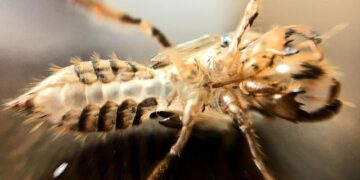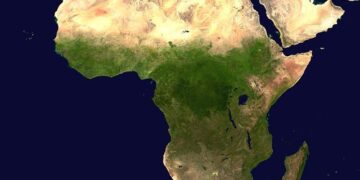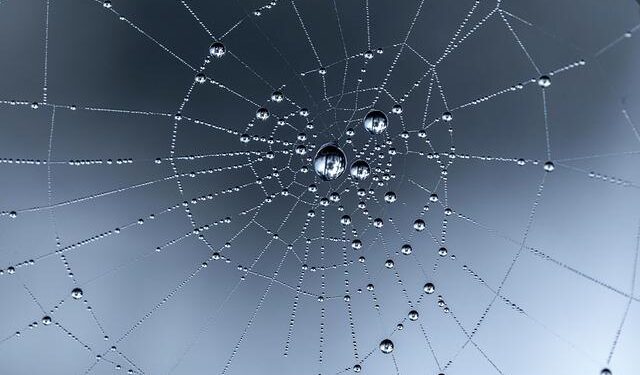A colossal spider web sprawled across the Greece-Albania border has captured global attention, potentially claiming the title of the world’s largest. The startling natural phenomenon, documented on video, reveals an intricate network of silk strands covering vast stretches of vegetation. Experts suggest that environmental factors, including flooding and an abundance of insects, may have contributed to the unprecedented scale of the web. The discovery offers a fascinating glimpse into the extraordinary adaptability of spiders and the complex ecosystems they inhabit.
Massive Spider Web Discovery on Greece Albania Border Draws Global Attention
Nestled along the rugged terrain of the Greece-Albania border, an extraordinary natural phenomenon has captivated scientists and nature enthusiasts worldwide. A sprawling spider web, stretching across fields and trees, is believed to be one of the largest ever documented. Experts note that this colossal creation, shimmering with morning dew, challenges previous records and provides a spectacular glimpse into the architectural marvels of arachnids. Initial investigations reveal that the web spans several hectares, employing the collective efforts of thousands of spiders working in coordination.
Researchers have begun to study the web’s unique structure and the environmental conditions that enabled its formation. Key observations include:
- Species involved: Majority belong to the Tegenaria and Agelenidae families.
- Team effort: Collaboration among spiders leading to an unusually massive communal web.
- Environmental factors: High humidity and calm winds facilitating web stability.
This discovery not only advances the understanding of arachnid behavior but also highlights the delicate balance between nature and climate. Local authorities are considering ways to protect this rare biological wonder as interest surges across ecological and travel communities.
| Aspect | Details |
|---|---|
| Location | Greece-Albania border region |
| Approximate Size | Several hectares |
| Spiders Count | Thousands working collectively |
| Climatic Conditions | High humidity, low wind |
| Research Status | Ongoing ecological studies |
Experts Analyze Web’s Unique Structure and Ecological Significance
The intricate design of this colossal spider web has captivated experts worldwide, revealing remarkable insights into arachnid engineering and ecosystem dynamics. Unlike typical webs, which are usually compact and focused on capturing individual prey, this expansive network stretches across dense vegetation and rugged terrain, showcasing an adaptive strategy that maximizes its surface area for trapping flying insects over vast distances. Researchers suggest that the web’s specific anchoring points and tension balance reflect evolutionary fine-tuning unique to this geographic region’s climate and biodiversity.
Beyond its physical marvel, the web plays a crucial ecological role by acting as an organic pest control system. Preliminary studies indicate a significant reduction in populations of agricultural pests within its vicinity, underscoring the web’s potential contribution to maintaining ecological balance. Key features highlighted by experts include:
- Exceptional tensile strength attributed to specialized silk proteins
- Strategic positioning to optimize exposure to insect flight paths
- Collaboration among multiple spider colonies suggesting a rare social behavior
| Web Feature | Description | Ecological Impact | |||||||||||||||||||||||
|---|---|---|---|---|---|---|---|---|---|---|---|---|---|---|---|---|---|---|---|---|---|---|---|---|---|
| Silk Composition | Highly elastic & strong proteins | Durability against weather extremes | |||||||||||||||||||||||
| Form & Scale | Spanning over several meters | Mass capture of flying insects
If you’d like, I can also help summarize, format, or extend your post further! Calls for Conservation Efforts to Protect Delicate Border EcosystemThe discovery of this massive spider web spanning the Greece-Albania border has sparked urgent calls from environmentalists and local communities to intensify protection measures for the fragile ecosystem hosting this natural wonder. Experts warn that the unique biodiversity supporting these spiders is under threat from deforestation, agricultural expansion, and unregulated tourism. Without immediate action, this ecological marvel-and countless other species reliant on the delicate balance of this border region-could face irreparable damage. Advocates emphasize the importance of cross-border cooperation in conservation strategies, highlighting the need to:
Closing RemarksAs scientists continue to study this extraordinary natural phenomenon, the massive spider web spanning the Greece-Albania border offers a rare glimpse into the intricate behaviors of spiders on a grand scale. Whether confirmed as the world’s largest, this web highlights the remarkable adaptability of wildlife in unexpected environments. Further research will shed light on the ecological factors behind its creation and the species involved, adding valuable knowledge to our understanding of biodiversity in the region. |































